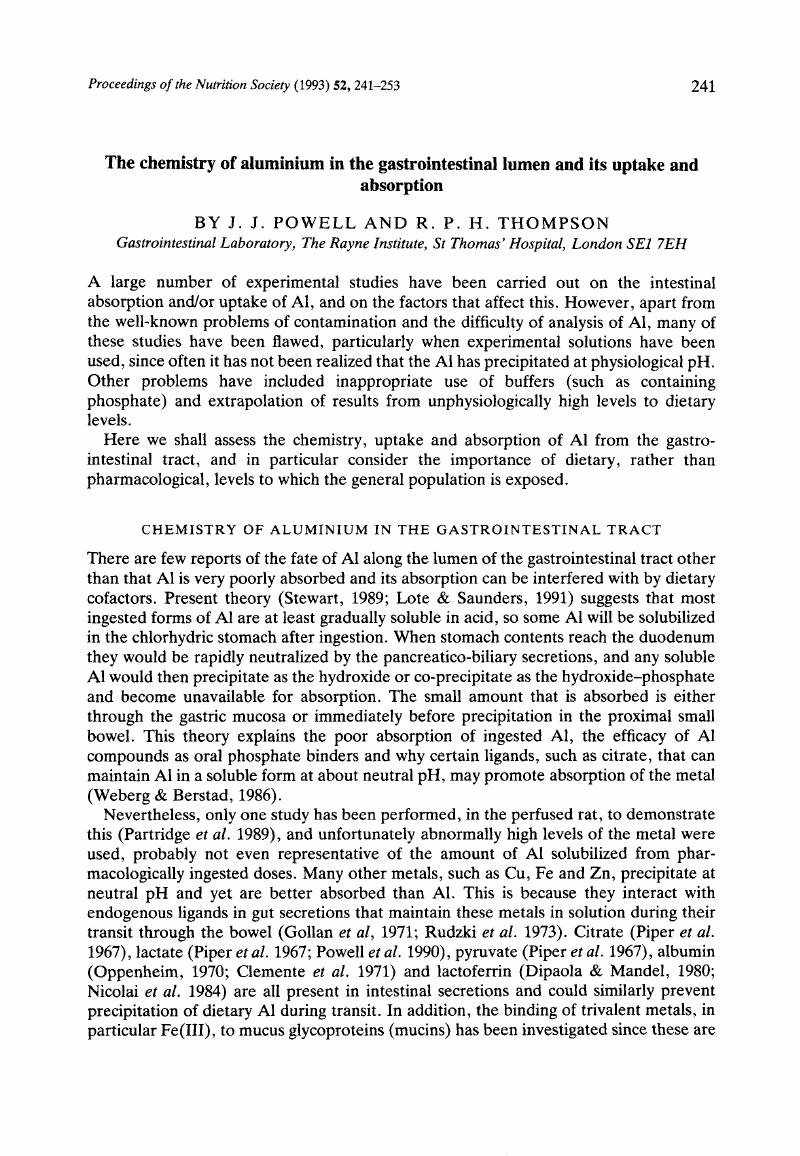Crossref Citations
This article has been cited by the following publications. This list is generated based on data provided by Crossref.
Evans, Peter H.
1994.
Nutrient and toxin interactions in neurodegenerative disease.
Proceedings of the Nutrition Society,
Vol. 53,
Issue. 2,
p.
431.
Danielsson, Lars-Göran
Zhang, Yu-Hui
and
Sparén, Anders
1995.
Mechanized method for measuring metal partition in n-octanol–aqueous systems. Partition of aluminium complexes.
The Analyst,
Vol. 120,
Issue. 10,
p.
2513.
Smith, B.
Breward, N.
Crawford, M. B.
Galimaka, D.
Mushiri, S. M.
and
Reeder, S.
1996.
The environmental geochemistry of aluminium in tropical terrains and its implications to health.
Geological Society, London, Special Publications,
Vol. 113,
Issue. 1,
p.
141.
Greger, J. L.
Sutherland, Jessica E.
and
Yokel, Robert
1997.
Aluminum Exposure and Metabolism.
Critical Reviews in Clinical Laboratory Sciences,
Vol. 34,
Issue. 5,
p.
439.
Whitehead, MW
Farrar, G
Christie, GL
Blair, JA
Thompson, RP
and
Powell, JJ
1997.
Mechanisms of aluminum absorption in rats.
The American Journal of Clinical Nutrition,
Vol. 65,
Issue. 5,
p.
1446.
Sánchez, Domènec J.
Gómez, Mercedes
Llobet, Juan M.
Corbella, Jacint
and
Domingo, José L.
1997.
Effects of Aluminium on the Mineral Metabolism of Rats in Relation to Age.
Pharmacology & Toxicology,
Vol. 80,
Issue. 1,
p.
11.
Deng, Zeyuan
Coudray, Charles
Gouzoux, Laurent
Mazur, Andrzej
Rayssiguier, Yves
and
Pépin, Denise
1998.
Effect of oral aluminum and aluminum citrate on blood level and short-term tissue distribution of aluminum in the rat.
Biological Trace Element Research,
Vol. 63,
Issue. 2,
p.
139.
Sutherland, Jessica E
and
Greger, J.L
1998.
Kinetics of aluminum disposition after ingestion of low to moderate pharmacological doses of aluminum..
Toxicology,
Vol. 126,
Issue. 2,
p.
115.
Borak, Jonathan
and
Wise, John Pierce
1998.
Does aluminum exposure of pregnant animals lead to accumulation in mothers or their offspring?.
Teratology,
Vol. 57,
Issue. 3,
p.
127.
Burden, T J
Whitehead, M W
Thompson, R P H
and
Powell, J J
1998.
Preparation of Urine Samples for Trace Metal Determination: A Study with Aluminium Analysis by Inductively Coupled Plasma Optical Emission Spectrometry.
Annals of Clinical Biochemistry: International Journal of Laboratory Medicine,
Vol. 35,
Issue. 2,
p.
245.
Dissanayake, C.B
and
Chandrajith, Rohana
1999.
Medical geochemistry of tropical environments.
Earth-Science Reviews,
Vol. 47,
Issue. 3-4,
p.
219.
Powell, J. J.
Jugdaohsingh, R.
and
Thompson, R. P. H.
1999.
The regulation of mineral absorption in the gastrointestinal tract.
Proceedings of the Nutrition Society,
Vol. 58,
Issue. 1,
p.
147.
Pimentel Vieira, Vânia Lúcia
Rocha, João Batista Teixeira
Schetinger, Maria Rosa Chitolina
Morsch, Vera Maria
Rodrigues, Sirlene Roseli
Tuerlinckz, Sandro Moreira
Bohrer, Denise
and
do Nascimento, Paulo Cı́cero
2000.
Effect of aluminum on δ-aminolevulinic acid dehydratase from mouse blood.
Toxicology Letters,
Vol. 117,
Issue. 1-2,
p.
45.
Jugdaohsingh, Ravin
Reffitt, David M
Oldham, Claire
Day, J Phillip
Fifield, L Keith
Thompson, Richard PH
and
Powell, Jonathan J
2000.
Oligomeric but not monomeric silica prevents aluminum absorption in humans.
The American Journal of Clinical Nutrition,
Vol. 71,
Issue. 4,
p.
944.
Powell, J.J
Harvey, R.S.J
Ashwood, P
Wolstencroft, R
Gershwin, M.E
and
Thompson, R.P.H
2000.
Immune Potentiation of Ultrafine Dietary Particles in Normal Subjects and Patients with Inflammatory Bowel Disease.
Journal of Autoimmunity,
Vol. 14,
Issue. 1,
p.
99.
PLANT, JANE
SMITH, DAVID
SMITH, BARRY
and
WILLIAMS, LORRAINE
2000.
Environmental geochemistry at the global scale.
Journal of the Geological Society,
Vol. 157,
Issue. 4,
p.
837.
Kádár, Enikõ
Salánki, János
Jugdaohsingh, Ravin
Powell, Jonathan J
McCrohan, Catherine R
and
White, Keith N
2001.
Avoidance responses to aluminium in the freshwater bivalve Anodonta cygnea.
Aquatic Toxicology,
Vol. 55,
Issue. 3-4,
p.
137.
Djurdjevic, Predrag
Jelikic-Stankov, Milena
and
Lazarevic, Ivan
2001.
The Effect of Surfactants on Equilibria in Aluminium(III) Ion + Ofloxacin Solution and Adsorption of Ofloxacin on Aluminium-Oxide.
Bulletin of the Chemical Society of Japan,
Vol. 74,
Issue. 7,
p.
1261.
Rankin, B J
Zhu, H
Webb, M
and
Roberts, N B
2001.
The development and in-vitro evaluation of novel mixed metal hydroxy-carbonate compounds as phosphate binders.
Journal of Pharmacy and Pharmacology,
Vol. 53,
Issue. 3,
p.
361.
Rankin, B J
Thewles, A
Lote, C J
Webb, M
and
Roberts, N B
2001.
The evaluation of novel mixed metal hydroxy-carbonates as phosphate binders: an in-vivo study in the rat.
Journal of Pharmacy and Pharmacology,
Vol. 53,
Issue. 4,
p.
513.



